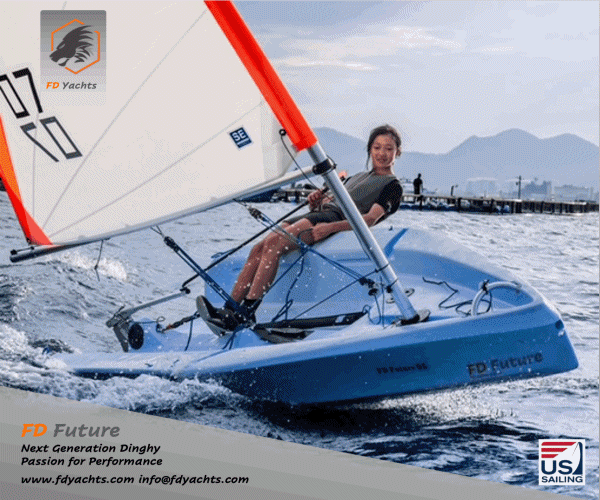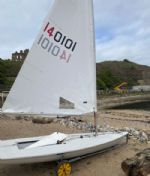












| Rossiter Pintail Mortagne sur Gironde, near Bordeaux |
 |
| Laser 28 - Excellent example of this great design Hamble le rice |
 |
| Laser 140101 Tynemouth |
 |
List classes of boat for sale |
Sailing rules |
Post Reply 
|
Page 123 7> |
| Author | |
farc anal 
Groupie 

Joined: 11 Oct 07 Location: one stop short of Tooting Online Status: Offline Posts: 54 |
 Post Options Post Options
 Quote Quote  Reply Reply
 Topic: Sailing rules Topic: Sailing rulesPosted: 27 Apr 09 at 2:04pm |
|
Bryan Willis adds his interperatation to this ripe cherry :) Been a while since we've done one of these, so let's get to it: The Rules Guy, Bryan Willis. But if you just take the situation you describe, and if both boats are sailing steady courses, then both boats are on starboard tack and both are on the other boat’s leeward side, so neither is windward boat, and rule 11 doesn’t apply. The only rule that can be applied is rule 14 requiring each to avoid contact with the other and if there is damage, both boats could be penalized. |
|
 |
|
gordon 
Really should get out more 
Joined: 07 Sep 04 Online Status: Offline Posts: 1037 |
 Post Options Post Options
 Quote Quote  Reply Reply
 Posted: 03 May 06 at 3:24pm Posted: 03 May 06 at 3:24pm |
|
As both boats are on the same tack and neither boat is clear astern of the other then, according to the RRS definition, they are overlapped even though they are approaching from nearly reciprocal directions. A change of course by either boat would have to be very radical in order to break the overlap. This holds true for both scenarios that have been put forward. In one scenario this means that rule 11 applies and the windward boat keeps clear. The additional scenario I introduced is one (unlikely but it has happened) in which, because of the way RRS defines windward and leeward, there is no windward boat, both boats can claim to be leeward boat. Rule 11 is inapplicable so rule 14 obliges both boats to avoid contact. Gordon PS If applying the rules as they are written, precisely and in accordance with the policy of ISAF, constitutes "an overating or parading of book-learning or technical knowledge or an insistance on strict adherance to formal rules, or even being possessed by by a doctrinaire theory " (such is the definition of pedantic) then I am proud to say that I am guilty as charged. The current rules are simple, short and logically structured. The essential rules for when boats meet are a mere 4.5 pages long. There is little excuse for not using these rules precisely.
|
|
|
Gordon
|
|
 |
|
sargesail 
Really should get out more 
Joined: 14 Jan 06 Location: United Kingdom Online Status: Offline Posts: 1459 |
 Post Options Post Options
 Quote Quote  Reply Reply
 Posted: 03 May 06 at 2:29pm Posted: 03 May 06 at 2:29pm |
|
To go back to my points on page 5 which concerned establishment of overlap and on which stefan quite rightly corrected my assumptions - I am intrigues as to how folk view the fact that any significant luff by the by the lee boat will create an overlap - and it will then clearly be windward boat - this would aslo be the case if the boats meet anything other than bow to bow (if you allow my assumption that the by the lee-er is unlikley to try and run underneath the close-hauler! - a fair one I think). So if there is course changing as described by John (and eventually agreed by Gordon "I'm not a pedant - I'm pedantic!" (firmly tongue in cheek and with apologies!!). then the likelihood is that the boats have been overlapped - that he put himself there and that therefore he should assume that it is for him to keep clear - apply Gordon's gybe solution - or head up and reach round the back! The close hauler should be in the clear - if he becomes right of way boat it is not through his action - though clearly he must avoid a collision.
|
|
 |
|
gordon 
Really should get out more 
Joined: 07 Sep 04 Online Status: Offline Posts: 1037 |
 Post Options Post Options
 Quote Quote  Reply Reply
 Posted: 02 May 06 at 8:19pm Posted: 02 May 06 at 8:19pm |
|
Rule 14 obliges a boat to avoid contact "if reasonably possible". In addition a right of way boat, or one entitled to room, only has to take avoiding action when it becomes clear that the other boat will not keep clear. In this case the protest committee may conclude that the situation was somewhat uncertain (the time we have spent discussing it is proof of that), and that both boats have suffered major damage affecting their result in the race and maybe the series. If I was chairing the protest committee I would be tempted to conclude that the damage was a sufficient penalty and that there was no need to inflict a penalty such as disqualification. On the other hand, if there was evidence that one or both boats had had a reasonable opportunity to avoid contact and had taken no action to do so, then disqualification would be an appropriate penalty. The decsion would depend upon the facts established according to what the competitors said in the protest room.
Gordon |
|
|
Gordon
|
|
 |
|
John Wilson 
Newbie 
Joined: 04 Oct 05 Online Status: Offline Posts: 26 |
 Post Options Post Options
 Quote Quote  Reply Reply
 Posted: 02 May 06 at 7:13pm Posted: 02 May 06 at 7:13pm |
|
No, I did not! It was a beautiful, wonderfully cared for ent! I don't think it was exactly the same as it was an ent, so he def wasn't running by the lee. So one of us had right of way, my memory is too fuzzy to remember who though (is that selective memory?). I seem to think I might have been keep clear boat! Anyway, we were both lucky that we didn't end up with any holes. It could have been loads worse. Although, it didn't feel that way at the time! |
|
 |
|
Calum_Reid 
Groupie 

Joined: 09 Apr 04 Location: United Kingdom Online Status: Offline Posts: 59 |
 Post Options Post Options
 Quote Quote  Reply Reply
 Posted: 02 May 06 at 6:52pm Posted: 02 May 06 at 6:52pm |
|
hehe john. U didnt pick the best of boats to get into that incident did u?

|
|

|
|
 |
|
John Wilson 
Newbie 
Joined: 04 Oct 05 Online Status: Offline Posts: 26 |
 Post Options Post Options
 Quote Quote  Reply Reply
 Posted: 02 May 06 at 6:33pm Posted: 02 May 06 at 6:33pm |
|
Thanks, gordon. I think that covered all of them. I didn't really mean all of them to be answered; they were kind of a thought process, one assumption leading on to the other, that lead onto the last question (ie the beating boat would win the protest). It seems that if you accept the assumptions, after verification that the by the lee boat has actually changed direction, the beating boat would most likely take the protest if there was a case of not enough time to keep clear. The if there was enough time to keep clear after the change & they are subsequently heading in exactly the opposite directions, on a collision course then rule 14 is the only rule in force. This last point, where rule 14 applies, seems to be a weak point in the rules, where both boats are required to avoid a collision. I have in my past had a "pavement" incident where I have been walking directly towards someone coming the other way on the street, one steps to one side to avoid & the other steps the same way & so we are on a collision course again & so we both step back, etc until they meet & collide. Funny when it happens on the pavement - but not so on the water! What, in your opinion, would a protest committee decide in a situation like this if both boats have major damage? |
|
 |
|
gordon 
Really should get out more 
Joined: 07 Sep 04 Online Status: Offline Posts: 1037 |
 Post Options Post Options
 Quote Quote  Reply Reply
 Posted: 02 May 06 at 12:59am Posted: 02 May 06 at 12:59am |
|
running by the lee to go as far as heading straight towards a beating boat on the same tack is going to be surfing on waves? And surely then they are going to be doing transitions between broad reaching & running by the lee? Surely then this is changing course & they are going to have to give the beating boat room to keep clear (under rule 15), which must surely be a considerable time as they are going to have to tack? And so in the event of a collision the beating boat will argue this & take the protest?"
My full answer to this and his last posting would be : 1.The situation I described MAY occur due to the existence of surfing conditions, but not necessarily. There may be other circumstances : fluky winds and RC sailing have been cited 2.A transition from a broad reach to running by the lee does not in itself constitute a change of course, as a boat might do this while sailing in a straight line. A change of course occurs when the direction in which the boat is travelling changes. 3. In the situation I described both boats could claim to be the right of way boat. Rule 15 does not apply as the right of way boat only has to give room "initially". 4. Rule 16.1 only applies IF a right of way boat changes course. If neither changes course then the rule does not apply. Only rule 14 applies. I would add that the beating boat does not necessarily have to tack in order to avoid contact. 5. If in a protest a competitor states that a boat changed course BECAUSE they went from a broad reach to running by the lee the protest committee should verify that the boat in question did in fact change the direction in which it was travelling. The competitors case would be stronger if they could demonstrate that this direction did in fact change. This is not being pedantic, merely trying to establish the facts. 6. Unfortunately, despite the best efforts of protest committees to ensure that competitors who may be unfamiliar with the rules and protest procedure can express themselves, the competitor who has studied the rules and has experience of protests will always have an advantage. Which is why any keen racing sailor should read the rules, protest when necessary, and volunteer to sit on protest committees. The protest committe can only make a decision on the basis of the information that is presented to them 7. The language used in the rules has been greatly simplified over the years. Whenever a word is used in the rules in a way that is in anyway different from a dictionary definition the rules give a definition - the use in the rules of windward and leeward being a good example. 8.A protest committee should not make a decision directly on the information given by competitors. This information is used by the protest committee to establish, to the best of their ablities, a description of the incident. It is at this point that the work of "translating" competitors testimony into the language of the rules will be at it's most intense. It is only when the facts are established that a protest committee should consider which rules apply and if a rule has been infringed 9. Personally, whenever I chair a protest committee I always offer, after having given the formal decsion of the committee, to explain the ruling, with reference, when necessary, to the Case Book. This is especially important when the decision is based on a legal nicety, or on an interpretation of the rules that may not seem obvious. After all protests are heard I am available, usually somewhere near the bar, to answer any queries on the rules, on incidents that occured during the day, or any other points arising. I also prefer to be out on the water during racing, even when there is no judging on the water. 10. If, in the situation I described, in a diagram, some time ago, if neither boat changes course and there is contact then both boats have infringed rule 14 and the protest committe would have to consider if a penalty is appropriate. If one boat changes course then they are obliged to give the other boat room to keep clear. The protest committee would have to decide whether the boat that had changed course had left enough room. 11. The best option for the by the lee boat would be to gybe on to starboard in good time to let the beating boat time to keep clear.
Hope this answers your questions. |
|
|
Gordon
|
|
 |
|
John Wilson 
Newbie 
Joined: 04 Oct 05 Online Status: Offline Posts: 26 |
 Post Options Post Options
 Quote Quote  Reply Reply
 Posted: 01 May 06 at 10:25pm Posted: 01 May 06 at 10:25pm |
I still don't know what your opinion on my statement is gordon, now that we have cleared up that there was a change in direction, that is. This wasn't my question though - it was would the running by the lee boat win the protest in the scenario I gave? Also on your point about taking what is said literally I find ludicrous. You are picking on technicalities to return the verdict; this will not produce justice in many situations. The rules are there to help us enjoy our racing and this can only be done by using them sensibly and putting the right people on the protest committees. These people should not necessarily be those most knowledgeable on the rules but those that can best establish the actual circumstances & apply the rules. Also to put a duty on the protester as opposed to the protest committee for stating the incident in terms of the rules doesn't make sense to me. The protester is likely to be going through the situation for one of very few times in his/her life, the protest committee should have far more experience & so help with getting the competitor through the rules, especially by asking questions where they see such ambiguity as you have pointed out in my first post. By being in effect the link between plain English, spoken by the competitors & the officious nature of the rules with this plain English, from the protester, being translated into rule based language by the committee & applied to the rule book. This is the sensible way to be & to have over officious protest decisions will only lead to disolusionment amongst those sailors & ulimitly harm our sport.
Edited by John Wilson |
|
 |
|
gordon 
Really should get out more 
Joined: 07 Sep 04 Online Status: Offline Posts: 1037 |
 Post Options Post Options
 Quote Quote  Reply Reply
 Posted: 01 May 06 at 8:52pm Posted: 01 May 06 at 8:52pm |
|
Steffan, I think I did answer John's point by reminding him that, for the rules, a change of course is a change in the direction in which a boat is heading, not a change in the angle between the wind direction (real or apparent) and the axis of the boat. There are many situations in which this angle may change, surfing being one, fluky winds another, however this change does not constitute a change of course. Gordon |
|
|
Gordon
|
|
 |
|
Post Reply 
|
Page 123 7> |
| Forum Jump | Forum Permissions  You cannot post new topics in this forum You cannot reply to topics in this forum You cannot delete your posts in this forum You cannot edit your posts in this forum You cannot create polls in this forum You cannot vote in polls in this forum |
Copyright ©2001-2010 Web Wiz
Change your personal settings, or read our privacy policy












 Printable Version
Printable Version Delicious
Delicious Digg
Digg Facebook
Facebook Furl
Furl Google
Google MySpace
MySpace Newsvine
Newsvine reddit
reddit StumbleUpon
StumbleUpon Twitter
Twitter Windows Live
Windows Live Yahoo Bookmarks
Yahoo Bookmarks Topic Options
Topic Options

